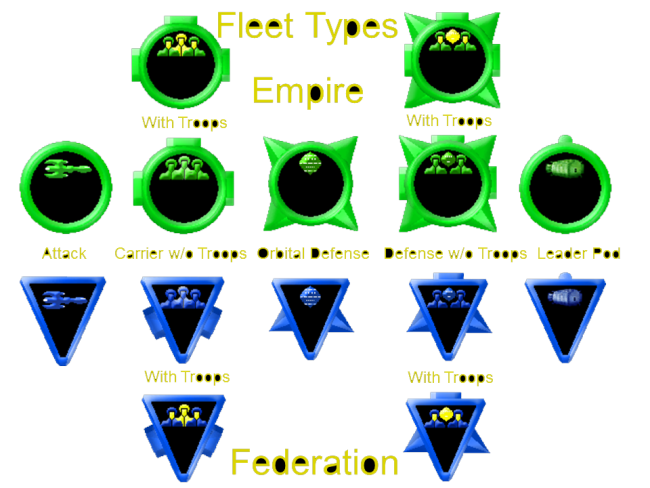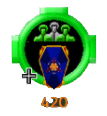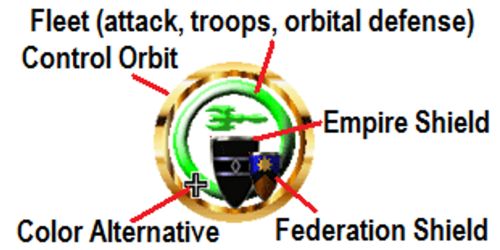Fleets
Ships are selected for a fleet based on how they will be used tactically in exploration, policing and battles.
General Information
A fleet is composed of at least 1 ship, but practically as a combination of 19 Ship Designs. An empire can support up to 64 unique fleets using the ship designs and leaders it controls.
- Each fleet has a unique name customized by the player.
- Empires start the game with the ability to field six fleets. Think of this as six fleet slots. It is possible to increase the number of slots.
- An empire begins with 19 Ship Designs from one of the 10 playable races.
- Federations can also deploy fleets.
Identification
Fleet icons identify the fleet type, the empire’s heraldry, federation affiliation if applicable, player relationship to fleet (see below) and its size. The fleet’s size is based on the tonnage of all the ships in the fleet--420 tons in the example above. An orbiting fleet’s relationship to the player’s empire is shown by color and with Color Alternatives when turned on:

|

|

|

|

|
Types
There are four types of fleets (Attack, Troop, Orbital and Escape Pod with several variations:
- Attack
- Transport Without Troops
- Transport With Troops
- Orbital
- Orbital Without Troops
- Orbital With Troops
- Escape Pod with Leader
 |
Controlling Orbit
A gold ring around a fleet icon means it controls orbit.
A fleet must control orbit before leaders and troops can disembark to an area on the world below. When two fleets are in orbit around the same world three things can happen:
- Both fleets abdicate orbital control which means neither can trade with or disembark troops to the surface.
- One fleet abdicates orbital control while the other fleet accepts control.
- The [Fleets Battle] for orbital control.
The first fleet in orbit does not automatically control orbit. A fleet action is needed.
Leadership
A Fleet does not need a leader, but having one with Space Combat skills can make a significant difference in the fleet's effectiveness. There is no practical limit to how many leaders may be assigned to a fleet.
Details
What follows are the types of information provided for ships and fleets:
| Jump Strength | The Gravity Rating that a fleet is able to overcome when traveling to another star. A fleet’s Jump Strength is equal to the lowest Jump Strength amongst its ships. | |
| Jump Distance | The area in which a ship can travel to known stars. A fleet's Jump Distance is equal to the smallest Jump Distance amongst its ships. | |
| Scan Strength | The ability to detect information about a star which is influenced by the star’s Gravity Rating. A fleet's Scan Strength is equal to the highest Scan Strength amongst its ships. | |
| Scan Distance | The area in which the fleet can identify other stars. A fleet's Scan Distance is equal to the highest Scan Distance amongst its ships. | |
| Tonnage | Mass of a ship. | |
| Transport Capacity | How many army units a fleet can transport. | |
| Hangers | One transport hanger per assault ship. | |
| Repairs | Repair capacity. |
Actions
Commands the player can give a fleet
Moving Ships
- The speed in which a fleet executes commands to move is determined by its’ slowest ship.
Move Fleet In-System
- Fleets can move to any planet, moon and the primary sun within a star system. A Fleet can be split by moving selected ships to an orbit around a different world--see Reconfiguring Fleets.
Move Fleet to Another Star System
- A Fleet can jump from the orbit of one star to another star. To do so it must be in-range of the fleet's Jump Distance and the sun’s Gravity Rating must be lower than the fleet's Jump Strength. A Fleet can be split by moving selected ships to an orbit around a different world--see Reconfiguring Fleets.
Abort Move
- Whatever time has passed before a move is aborted is also taken to return the fleet back to its starting position.
Traverse [Quantum Gate]
- Used to move Fleet directly to another world at a known location. Fleet must Control Orbit.

Traverse [Wormhole]
- Used to move Fleet directly to another world at a random location. Fleet must Control Orbit.

Moving Individuals & Equipment
Disembark Leader
- Transfer selected leader to an area on the surface.
Disembark Army
- Transfer selected army to an area on the surface.
Conflict
Attack Fleet
- Initiate a battle with a hostile fleet. Sometimes needed to gain control of a planet’s orbit.
Blockade Orbit
- Physically shutting down all Trade Route on all Markets on a world. Fleet must Control Orbit.

Interdict Trade
- Selectively shutting down a Trade Route on world Market. Fleet must Control Orbit.

Engage in Piracy
- Stealing goods from a Trade Route. Fleet must be in orbit, but does not need to Control Orbit.

Communication
Place Flag
Place Beacon
Housekeeping
Change Control Orbit Stance
- Gives fleet control of orbit if option is available or relinquishes control.
Rename Fleet
- Change Fleet’s name.
Performance
Information reported to Players about their fleets.
| Total Health | |
| Total Shield |
Reconfiguring Fleets
Fleets are reconfigured by splitting a fleet and moving some of its ships to a different world. When the empire has fleet in orbit there, these relocating ships are merged with it. If the empire does not have a fleet in orbit, a new fleet is created if there is an available fleet allocation slot. Otherwise, the move is aborted.

